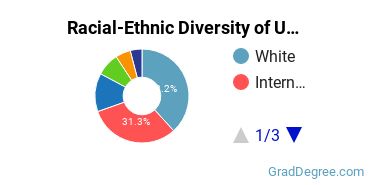University of North Texas Graduate Programs
Located in Denton, Texas, University of North Texas is a public institution. The surrounding area of the school is a good match for students who enjoy city life.
Featured schools near , edit
Where Is University of North Texas?

Contact details for UNT are given below.
| Contact Details | |
|---|---|
| Address: | 1501 W.Chestnut Ave., Denton, TX 76203-1277 |
| Phone: | 940-565-2000 |
| Website: | www.unt.edu |
University of North Texas Graduate Student Diversity
Gender Diversity
Of the 9,851 graduate students at UNT, 43% are male and 57% are female.

Racial-Ethnic Diversity
The racial-ethnic breakdown of University of North Texas graduate students is as follows.

| Race/Ethnicity | Number of Grads |
|---|---|
| Asian | 515 |
| Black or African American | 779 |
| Hispanic or Latino | 1,302 |
| White | 3,767 |
| International Students | 3,088 |
| Other Races/Ethnicities | 400 |
Geographic Diversity
Texas students aren't the only ones who study at University of North Texas. At this time, 43 states are represented by the student population at the school.
Over 121 countries are represented at UNT. The most popular countries sending students to the school are India, China, and Saudi Arabia.
Online Learning at University of North Texas
The following chart shows how the online learning population at UNT has changed over the last few years.

This school is the 3rd most popular in Texas for online learning according to the online graduations recorded by the Department of Education for the academic year 2022-2023.
The following table shows the 1-year growth rate of UNT majors that offer at least one online course. This table only includes majors with positive growth.
| Major | 1-Year Growth Rate |
|---|---|
| Business, Management & Marketing | 6% |
| Communication & Journalism | 8% |
| Computer & Information Sciences | 19% |
| English Language & Literature | 14% |
| Health Professions | 5% |
| Library Science | 6% |
| Mathematics & Statistics | 13% |
| Parks, Recreation, Leisure, & Fitness Studies | 11% |
University of North Texas Graduate Concentrations
The table below shows the number of awards for each concentration.
References
*The racial-ethnic minorities count is calculated by taking the total number of students and subtracting white students, international students, and students whose race/ethnicity was unknown. This number is then divided by the total number of students at the school to obtain the racial-ethnic minorities percentage.
- College Factual
- National Center for Education Statistics
- Image Credit: By Michael Barera under License
More about our data sources and methodologies.
Featured Schools
 Request Info
Request Info
|
Southern New Hampshire University You have goals. Southern New Hampshire University can help you get there. Whether you need a bachelor's degree to get into a career or want a master's degree to move up in your current career, SNHU has an online program for you. Find your degree from over 200 online programs. Learn More > |
